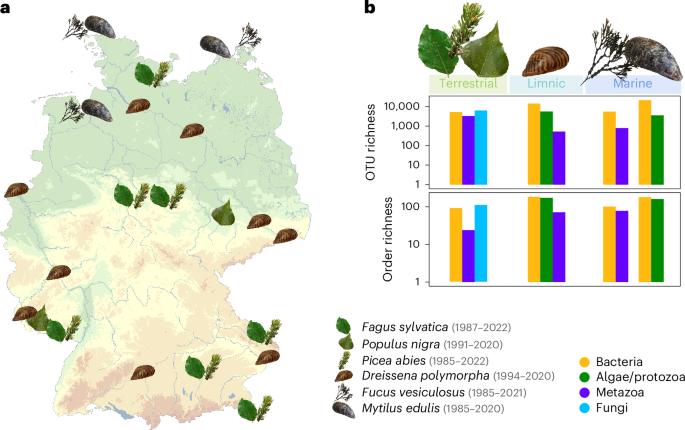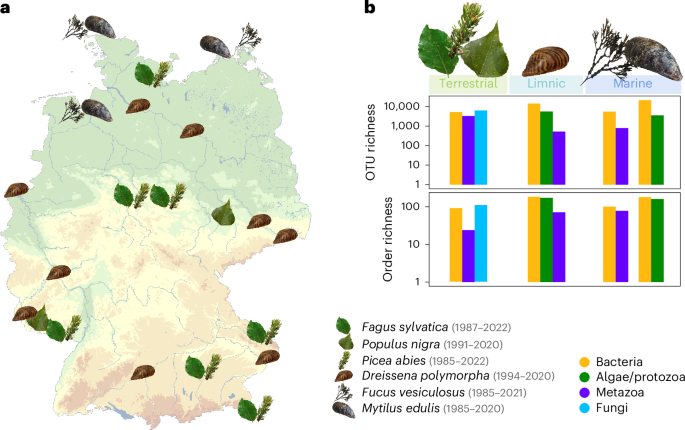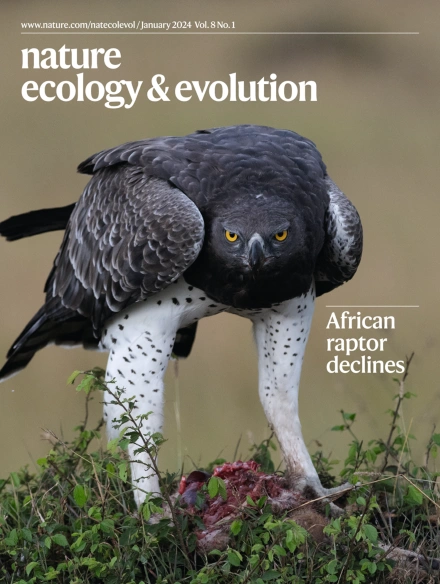Archived natural DNA samplers reveal four decades of biodiversity change across the tree of life
IF 13.9
1区 生物学
Q1 ECOLOGY
引用次数: 0
Abstract
Detecting the imprints of global environmental change on biological communities is a paramount task for ecological research. But a lack of standardized long-term biomonitoring data prevents a deeper understanding of biodiversity change in the Anthropocene. Novel sources of data for analysing biodiversity change across time and space are urgently needed. By metabarcoding highly standardized biota samples from a long-term pollution monitoring archive in Germany, we here analyse four decades of community diversity for tens of thousands of species across the tree of life. The archived samples—tree leaves, marine macroalgae, and marine and limnic mussels—represent natural community DNA samplers, preserving a taxonomically diverse imprint of their associated biodiversity at the time of collection. We find no evidence for universal diversity declines at the local scale. Instead, a gradual compositional turnover emerges as a universal pattern of temporal biodiversity change in Germany’s terrestrial and aquatic ecosystems. This turnover results in biotic homogenization in most terrestrial and marine communities. Limnic communities, in contrast, rather differentiate across space, probably due to the immigration of different invasive species into different sites. Our study highlights the immense promise of alternative sample sources to provide standardized time series data of biodiversity change in the Anthropocene. This study explores four decades of biodiversity change across the tree of life in Germany’s terrestrial and aquatic ecosystems by sequencing standardized biota samples from a long-term pollution monitoring archive.


存档的自然DNA样本揭示了四十年来整个生命之树的生物多样性变化
探测全球环境变化对生物群落的影响是生态学研究的首要任务。但是,缺乏标准化的长期生物监测数据阻碍了对人类世生物多样性变化的更深入了解。迫切需要新的数据来源来分析生物多样性的时空变化。通过对来自德国长期污染监测档案的高度标准化的生物群样本进行元条形码编码,我们在这里分析了四十年来生命树上成千上万个物种的群落多样性。这些存档的样本——树叶、海洋大型藻类、海洋和湖泊贻贝——代表了自然群落的DNA样本,在收集时保留了它们相关生物多样性的分类多样性印记。我们没有发现在地方尺度上普遍多样性下降的证据。相反,在德国陆地和水生生态系统中,逐渐的成分转换作为一种普遍的生物多样性变化模式出现。这种转换导致大多数陆地和海洋群落的生物同质化。相比之下,湖泊群落在空间上的差异很大,这可能是由于不同的入侵物种进入了不同的地点。我们的研究强调了替代样本来源的巨大前景,以提供人类世生物多样性变化的标准化时间序列数据。
本文章由计算机程序翻译,如有差异,请以英文原文为准。
求助全文
约1分钟内获得全文
求助全文
来源期刊

Nature ecology & evolution
Agricultural and Biological Sciences-Ecology, Evolution, Behavior and Systematics
CiteScore
22.20
自引率
2.40%
发文量
282
期刊介绍:
Nature Ecology & Evolution is interested in the full spectrum of ecological and evolutionary biology, encompassing approaches at the molecular, organismal, population, community and ecosystem levels, as well as relevant parts of the social sciences. Nature Ecology & Evolution provides a place where all researchers and policymakers interested in all aspects of life's diversity can come together to learn about the most accomplished and significant advances in the field and to discuss topical issues. An online-only monthly journal, our broad scope ensures that the research published reaches the widest possible audience of scientists.
 求助内容:
求助内容: 应助结果提醒方式:
应助结果提醒方式:


